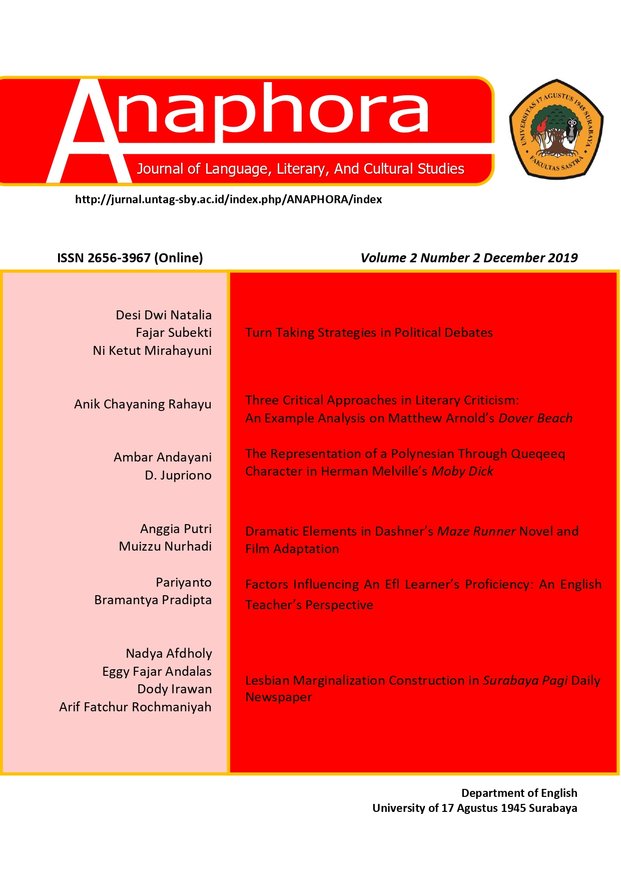THE REPRESENTATION OF A POLYNESIAN THROUGH QUEQEEQ CHARACTER IN HERMAN MELVILLE’S MOBY DICK
Abstract
This research applies a literary anthropology approach that focuses the study on the uniqueness of Queqeeq character represented in Moby Dick (Mellvill, 1962). That uniqueness contains physical characteristics as a Polynesian, cultural behavior, belief, and dialect. Queqeeq character is described as a very sober man, consistent in his words and manners, and referring to Polynesid race, with large black eyes, natural dark skin, and unworldly tattoos. Quegeeq is represented as a character of a hard worker, agile, and tough as a seaman in the Pacific ocean. In religion, Queqeeq is described as a primitive ritual-religion person, who is serious in fasting; not to eat and talk in the Ramadan time, prays ritually through a wooden idol, following the ritual-religion custom of Polynesian. Generally, it can be concluded that Melville in Moby Dick (1962) succeeds in representing the specific characteristics of Polynesian culture through character and characterization of QueqeeqDownloads
References
Ahimsa-Putra, H.S. (2003). Dari antropologi budaya ke sastra dan sebaliknya. In Arif, S. (ed.), Sastra interdisipliner menyandingkan sastra dan disiplin ilmu sosial. Yogyakarta: Qalam & Forum Sastra Banding.
Andayani, A. & Jupriono, D. (2019). Representation of Nyi Roro Kidul in myth, legend, and popular culture. Anaphora: Journal of Language, Literary, and Cultural Studies, 2(1), p. 28-36. http://jurnal.untag-sby.ac.id/index.php/ANAPHORA/ article/view/2724/2271. Access 10-12-2019.
Andayani, A. & Jupriono, D. (2018). Comparative literary study on Mochtar Lubis’ Harimau Harimau and Herman Melville’s Moby Dick. Parafrase 18(02). http://jurnal.untag-sby.ac.id/index.php/parafrase/article/view/1842/1548. Access 10-12-2019.
Andayani, A. (2018). Sartre’s existentialism in Herman Melville’s Moby Dick. Anaphora: Journal of Language, Literary, and Cultural Studies, 1(1), p. 23–27. http://jurnal.untag sby.ac.id/index.php/ANAPHORA/article/view/2086/1783. Access 10-12-2019.
Andayani, A. & Purbowati, E. (2016). Representasi multikulturalisme dalam novel Moby Dick karya Herman Melville. Parafrase 16(01). https://jurnal.untag-sby.ac.id/index.php/ parafrase/article/view/678/607. Access 10-12-2019.
Andayani, A. (2005). Literacy stylistics in Herman Melville’s Moby Dick: The study of the arrangement of ideas. Parafrase 5(1) February: p. 33-39.
Andayani, A. (1997). Nature as the inspiration source in Herman Melville’s Moby Dick. FSU in the Limelight 5(2), p. 103-108. http://www.angelfire.com/journal/fsulimelight/ nature.html. Access 10-12-2019.
Bernard, H.R. (2017). Research methods in anthropology: Qualitative and quantitative approaches. Sixth Edition. Lanham, Maryland: Rowman & Littlefield.
Budiman, K. (2003). Bila(kah) antropologi dan sastra bertemu. In Arif, S. (ed.), Sastra interdisipliner menyandingkan sastra dan disiplin ilmu sosial. Yogyakarta: Qalam & Forum Sastra Banding.
Kahn, M.; Kiste, R.C.; Suggs, R.C. (2020). Polynesian culture: Cultural region, Pacific Ocean. https://www.britannica.com/place/Polynesia/Religion. Access 10-01-2020.
Melville, Herman. (1962). Moby Dick. [1851]. New York: The Macmillan Co. [2004. New York: Castle Books].
Rodgers, S. (1993). A Batak antiquarian writes his culture: Print literacy and social thought in Indonesian society. In Benson, P. (ed.). Anthropology and literature. Urbana: University of Illinois Press.
Rose, D. (1993). Ethnography as a form of life: The written word and the work of the world. In Benson, P. (ed.). Anthropology and literature. Urbana: University of Illinois Press.
Authors whose manuscript is published will approve the following provisions:
-
The right to publication of all journal material published on the jurnal anaphora website is held by the editorial board with the author's knowledge (moral rights remain the property of the author).
-
The formal legal provisions for access to digital articles of this electronic journal are subject to the terms of the Creative Commons Attribution-ShareAlike (CC BY-SA) license, which means Jurnal Persona reserves the right to store, modify the format, administer in database, maintain and publish articles without requesting permission from the Author as long as it keeps the Author's name as the owner of Copyright.
-
Printed and electronic published manuscripts are open access for educational, research and library purposes. In addition to these objectives, the editorial board shall not be liable for violations of copyright law.




